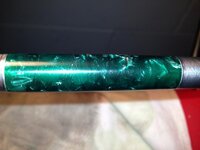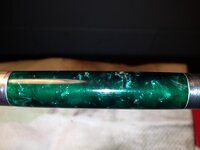OK, that is AA!!
So, the problem is, likely, you started sanding with too coarse sandpaper.
Acrylic will get deep scratches if you use anything under about 240 grit. Once you have the deep scratches, getting them out is a bear!!!
Emphasize the look of the blank, when you are sanding at about 400 grit (which is where I start, but that does not have to be the case). You should see thin, shallow scratches on the surface. IF you have any deep scratches, you have to sand them out with the 400 or 360 or so, when you get to 600, it will start getting shiny, but it won't remove deep scratches.
Sand with the lathe turning about 1000 RPM, but be aware of heat. If your fingers are getting hot, either go to wet sanding or stop and let it cool off, then continue.
Most of all, avoid making the deep scratches and you won't have to work nearly as hard.
Good luck--it only took me about a year and a couple dozen blanks to figure this out---the internet makes it much easier!!!
Welcome to IAP!!!!



